Despite the fact that these days, so much is being said, shown, and written about Ukraine and the war that Russia waged on her; despite all the news, numerous interviews and videos of President Zelensky speaking to whoever is willing to listen; despite constant buzz in the Ukrainian segments of social media where people coordinate humanitarian help, support to the territorial defense units, the relocation of people, and million other urgent matters; despite all these the inner condition, the state of being of the country is probably best defined by the word ‘silence.’
Silence can stem from different circumstances and possess various qualities. It can be voluntary or forced, deafening or revealing, powerful or paralyzing. What unites all these is absence as an antonym to presence; the absence of something that could have been but is not. This silence in Ukraine in the middle of murderous noise is the absence of the words, expressions, thoughts, actions, intentions that could have been said, stated, done, shown, uttered if there was no war.
Silence also does not necessarily mean the absence of people, quite the contrary – the more people whose voices have been silenced, the more deafening and horrible it grows. This is especially true when talking about culture: Ukrainian culture today is a void compiled of empty spaces that could have been filled with books, exhibitions, performances that did not happen – and most probably, will not happen for a long time.
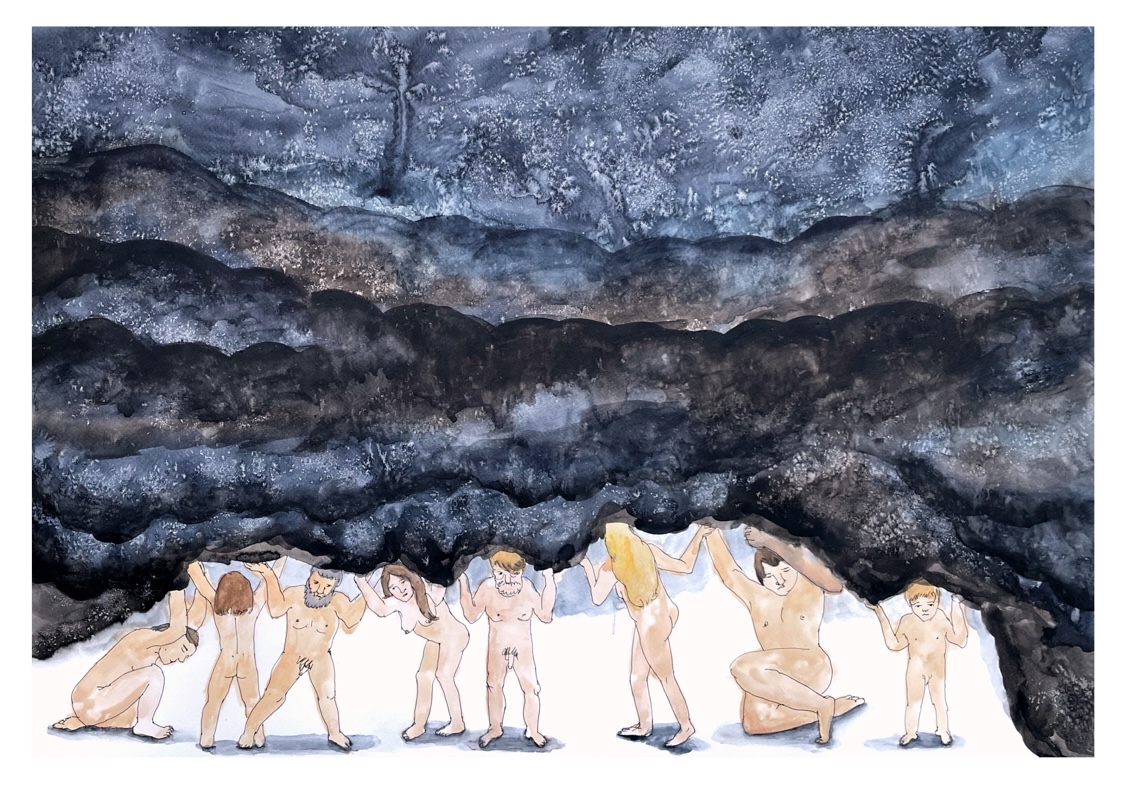
Kinder Album: Ukrainian Titans Holding Up the Sky. 2022, published on Instagram. Image courtesy of the artist Kinder Album.
Back in 2014, at the de facto onset of the current invasion – occupation of Crimea and the war in Eastern Ukraine, – the outstanding Ukrainian writer Oksana Zabuzhko switched from her writing to producing endless interviews and articles, predominantly for western media. She called it ‘getting into a tank’ – an expression which later became a title for her collection of essays and interviews.
Yet again, everything was brought to a halt on 24 February this year, but on much larger and more terrifying scale.
This time another outstanding Ukrainian writer, Sofia Andruchovych wrote: ‘Before the war, I was a writer. Today, on the ninth day, I feel unable to string two words together’.
Film director Marina Stepanska stated on her Facebook in A Letter from Ukraine: ‘I used to be a filmmaker, now I’m not.’
Meanwhile, artist Lesya Khomenko left everything in her studio in Kyiv and took to Ivano-Frankivsk in Western Ukraine with her daughter, and started a lab for displaced artists. She calls it ‘a therapeutic space’ to look at the current situation and try to deal with it through collaborative work. She says, ‘We left all our works behind, we are left with nothing, without a biography. When some might have their works digitalized, others like myself have only material pieces.’
So, what are the voices of the silence? What happens to art (and artists) during the war? The question is twofold. One problem is what happens instead of art that did not happen. The other: what happens to art that already happened.
The art that already happened
A few days after the war started, globalmedia picked up the story of Maria Prymachenko’s works being destroyed as a local history museum burned down after missile hit in Ivankiv, near Kyiv. The story went viral spreading from arts magazines and newspapers to mainstream media: colorful phantasmagoric images of Prymachenko’s imagined flora and fauna covering printed pages and newsletters.
Shortly after, thenews surfaced that some of the paintings may have been saved by locals – maybe even more than those destroyed. It is worth noting that the main collection of her works was stored elsewhere in the first place. Yet, this information never made it to the top headlines, and neither did the news about the destroyed or severely damaged museums in Kharkiv, Mariupol, or Chernihiv.
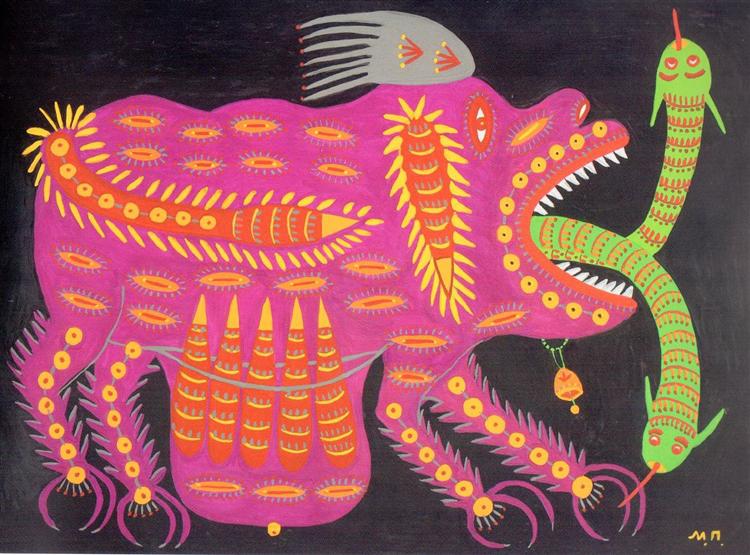
A powerful visionary painting by Maria Primachenko: May That Nuclear War Be Cursed! 1978. Fair Use via Wikiart.
Was this information simply swallowed by the tsunami of other news? Lost among the daily reports of children being killed, civilians kept hostage, whole cities destroyed? Maybe people simply more important than artworks, allowing the threat to lives overshadowing the problem of cultural heritage? It may have been affected by the authorities’ reinforced demand not to publish any visuals and not to disclose the locations of the missile hits and destruction?
Or was this silence already internalized and accepted? Did museum workers and cultural professionals remain silent because they understood that any information about the collections, their whereabouts, their conditions or further prospects equaled putting a target on them?
On the other hand, the uproar about the destruction of Prymachenko’s works might have concentrated on something other than the artist, or even the works. It might have been another omission created by the war, a tangible example of loss when destruction was the only story to tell.
In war, the materiality of destruction prevails over the materiality of existence. The physical pressure and the finite mass of the rubble left after the missile hits a building feels like the end of the sentence. All said. Period. Nothing can be done. Time to move on.
But those who survive, be they people or objects, need their stories and histories. Without them, Prymachenko stays a ‘folk’ artist whose works appeared on postal stamps, was awarded an art prize (notably, both these happened still under the Soviet Union), and was praised by Picasso. These little scraps of info were mentioned all over international media.
In this context, her unique story as an autodidact who never left her village, her cosmovisions of interconnectedness of life that blurred the borders between the reality and dreams, the role of her works for the generations of Ukrainian artists and in forging Ukrainian cultural identity have no place and no attention. In the place where a story should be told, there is silence.
Even more silence occupied places of stories that could have been told. Museum collections are stored in basements in undisclosed locations,: and museum directors refuse to talk about the specifics; activists raise funds and collect basic necessities to support the people who save the artworks. Grassroots initiatives like the Museum Crisis Center provide packaging material and fire extinguishers, prioritizing museums in small towns and villages. These objects of varying value, origin, and provenance,are parts of a cultural heritage that would need to be exhibited, contextualized and analyzed, woven into the complex history of a country whose people were deprived of history for a long time. But right now, security prevails over the need of storytelling.
And then there are the artworks of living artists too, left in studios and galleries basements, sometimes rescued by volunteers or fellow artists, sometimes already lost forever.
The art that did not happen
If some of these works are never to be recovered, what does it make them? Will they be merely a ‘lost biography’, in Lesya Khomenko’s words? Are they an already lost heritage? And what’s the difference? When and if the images, the digital copies of these works are to be exhibited sometime in the future, how will the present, material objects created by the same artists during the war look next to them? Perhaps, there will be a note, a small caption next to each of them saying something like ‘This work was not the one planned by the artist or created out of her/his good will. It was created by the war.’
Alevtina Kakhidze is one of the artists to document her experiences since the second day of the war, utilizing her vast international recognition and network all over Europe and in Russia. In her first war drawings – the first pages in her ongoing visual diary published on her Facebook page –, Alevtina tried to call on Russian artists and intellectuals to take to the streets.
Over the next days and weeks, she and her husband in their house in the suburbs of Kyiv with their dogs, enduring shelling and the threat of the possible invasion, her drawings transformed into imprints of her daily experiences. Starting from sleeping in the basement without electricity or internet connection, spanning all the way into visual discussions about the origin of Russian imperialism and the need to decolonize Russian culture.
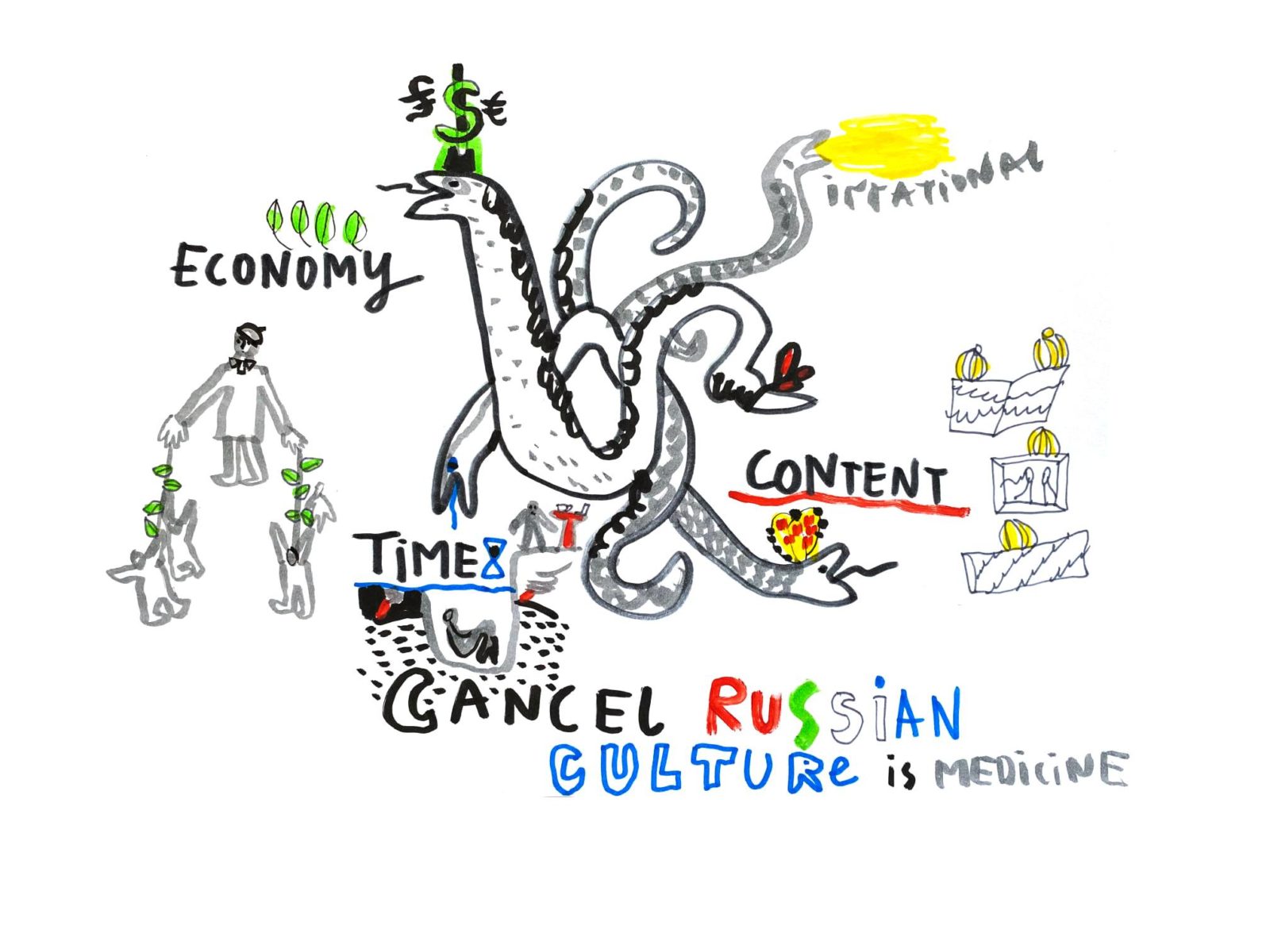
Alevtina Kakhidze, Cancel Russian culture. 2022, published on Facebook. Image courtesy of the artist Alevtina Kakhidze.
Alevtina, who is also a performance artist, picked up her peculiar visual language of fast drawing, small on-the-go sketches in a previous series of works where she criticized consumer society. But her world changed in 2014 when war became a huge part of her realilty because her mother, as so many other people of age, refused to leave their homes on the occupied territories in Eastern Ukraine.
Phone calls between mother and the daughter, sketches of the mother’s life under the occupation, and other aspects of the war’s political reality built up an extensive visual diary; 2D performances where colorful schematic figures were surrounded by words in different languages – Russian, Ukrainian, English.
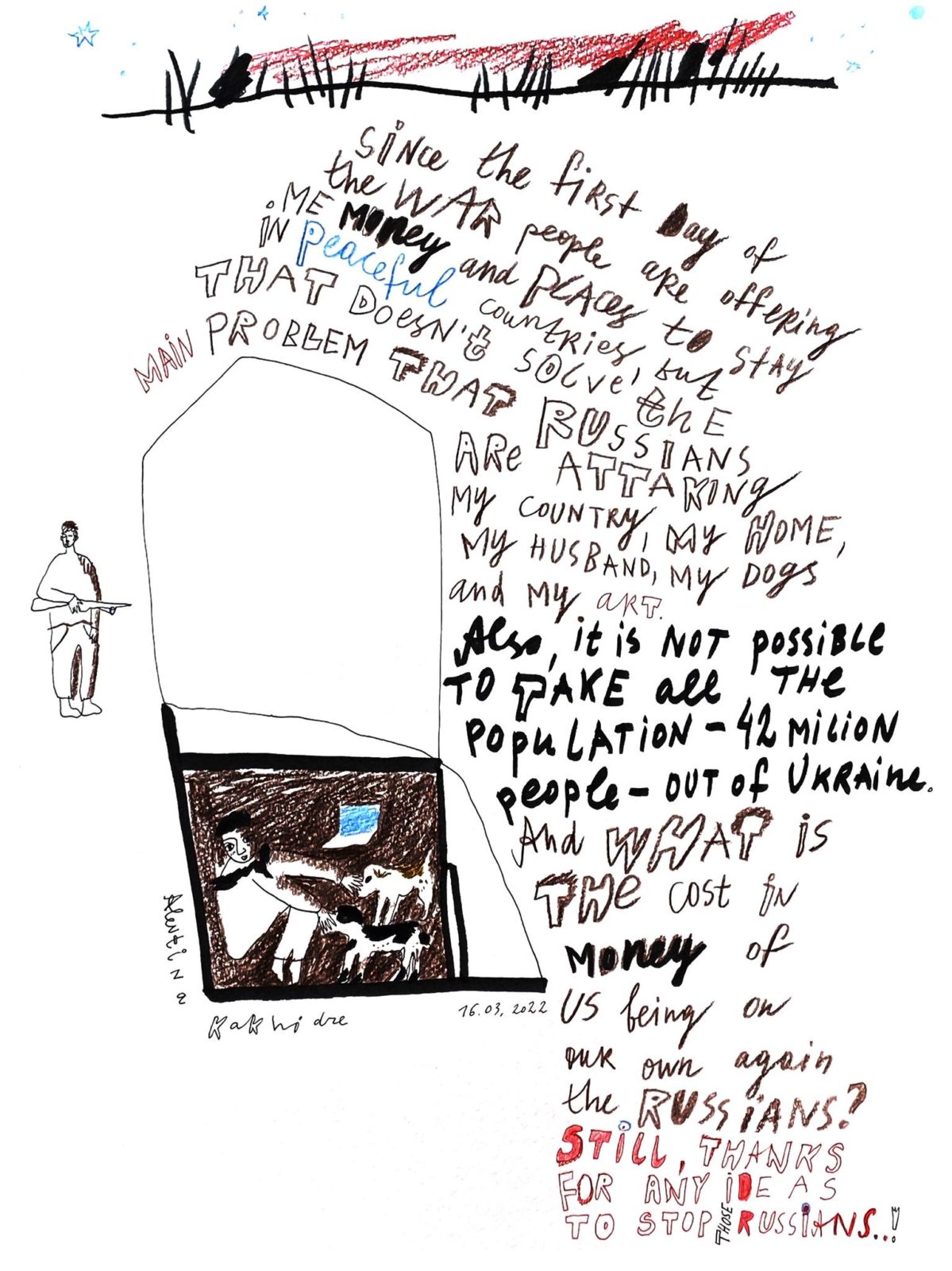
Alevtina Kakhidze, Birthday. 2022, published on Facebook, available via Artists for Ukraine. Image courtesy of the artist Alevtina Kakhidze.
These drawings from 2014 on are not sketches for something else, not preparation for the bigger work, as artists’ diaries and sketchbooks often are. They are snapshots of the moment, visual notes, messages mainly to oneself (and then, to others) not to forget, not to let go even if sometimes that’s exactly what one yearns to do..
Maidan, the occupation of Crimea, and the war in Donbas have changed not just the visual language, but the way artists perceive themselves. As many said during, and especially right after Maidan: when the unthinkable and unimaginable was happening, artists turned into regular citizens, activists, human beings doing whatever they could to help the situation. Even more important, however, was that the inner permission ‘to not be an artist’: allowed not to imagine or reflect, let alone represent, but instead collect, record, save, and try to keep reality intact.
Already then, eight years before the full-scale invasion and war unfolded, artists were collecting the evidence of atrocities. The struggle for a visual language to grasp and speak about the reality was an attempt to (re)claim agency and to own the narrative, to dare and see the war and its aftermath with their own understanding, not through the imagery supplied by mass-media or commercial culture, and avoiding the recycling art of other wars or conflicts. The aim has been to build a unique form of expression, one that transcends mere tropes; one that is true to the reality of the here and now.
Peripheral vision
Writing about the frames of war, Judith Butler inquired about how the framing of the image of war through cameras affects the materiality of war and influences public discourse about it. She extensively analyzed how the frame of an image includes and excludes certain parts of a narrative, forming resistance potential on the margins; in those zones of exclusion something is undisclosed and the numbers of casualties are not self-explanatory (1). However, Butler writes about the politics of framing the materiality of war for the external gaze. But what happens on the inside, when the perception is framed by someone’s own eyes? What will fall on a blind spot, what is oushed to the periphery?
For those living the daily reality of this current war, the materiality and violence are framed by the Ukrainan government’s explicit ban on the use of the immediate images of destruction – this ban was introduced for security reasons, however, there is an increasing number of cases of international media and Telegram channels violating this ban.
This experience is complemented by the unspoken expectation of international media to limit the expression of strong emotions. It somehow seems that being openly emotional, like expressing pain or rage, deprives the speaker, regardless of her or his recent experience, of the assumptions of rationality, dignity, and thus of agency and a valid voice.
It is on the margins of this frame that artists often step in.
‘My husband, artist and musician @maxrobotov is a lieutenant in the Ukrainian army now. He sent me his photo because I was curious what it looked like. Taking photos of soldiers and military objects is forbidden now in Ukraine because of the war. Before the escalation of the war, I was contemplating the commonalitiesof the military optic and artistic view. Max represents both positions now,’ wrote Lesya Khomenko on her Facebook page in mid-March. Below is her painting of the photo of her husband, bareheaded, in half-military half-civilian clothes, giving military salute. It’s her first work after February 24 and after relocation to Western Ukraine. Somewhere behind the surface of this clearly distanced, even formal painting and behind the artist’s calm words is fear, suffocating fear never to be able to see your loved one again.
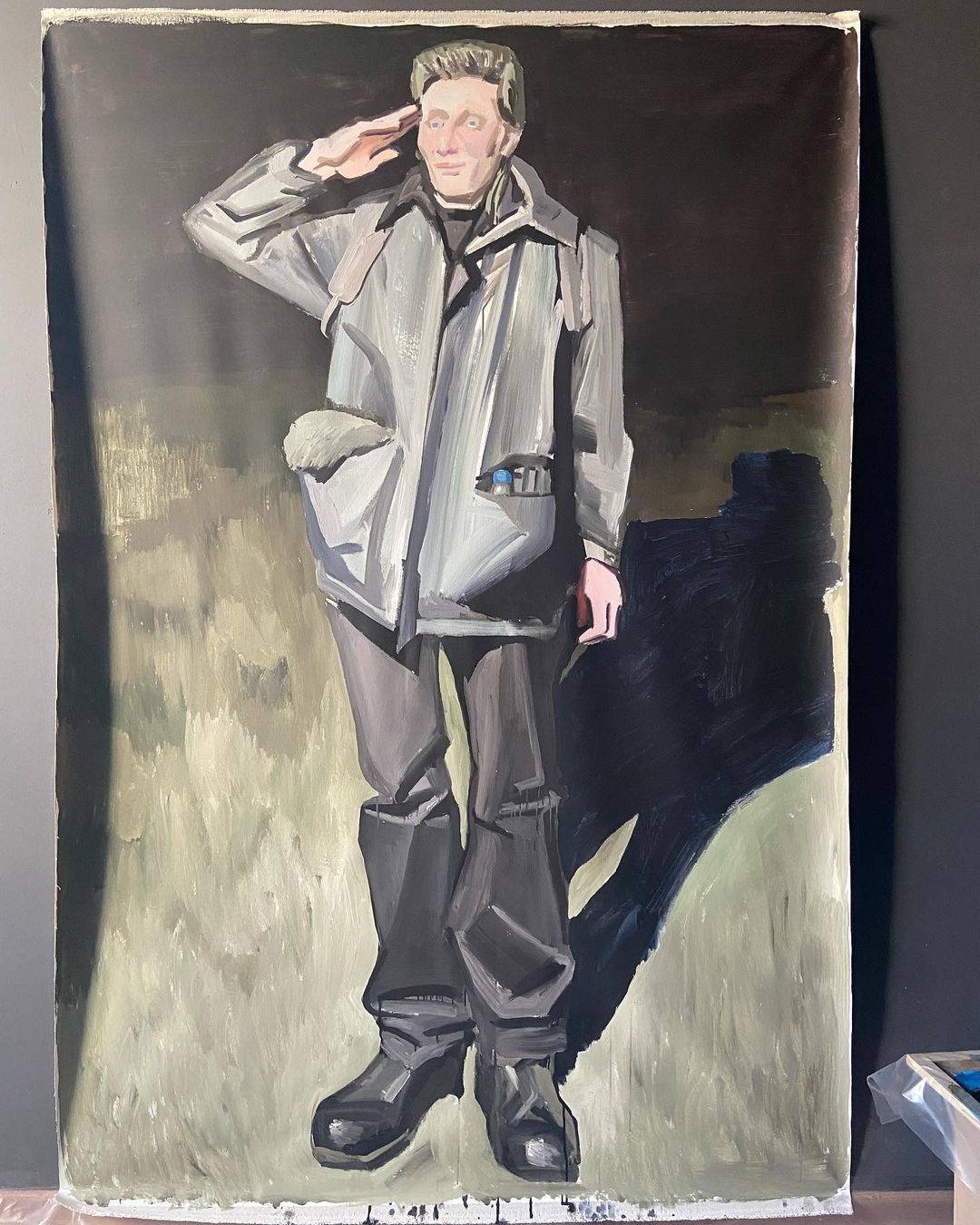
Lesya Khomenko’s portrait of her husband, based on a photo, 2022. Image courtesy of the artist Lesya Khomenko.
Kateryna Lysovenko spent a few nights in a bomb shelter in Kyiv with her two children and a cat before relocating first to Lviv, then to Poland, and soon to Austria. Lysovenko created a number of smaller watercolours while on the road. Schematic, flat, almost faceless figures stand against the grim background, almost dissolving in it. One of the works says ‘Propaganda of the living world. Stop murder.’
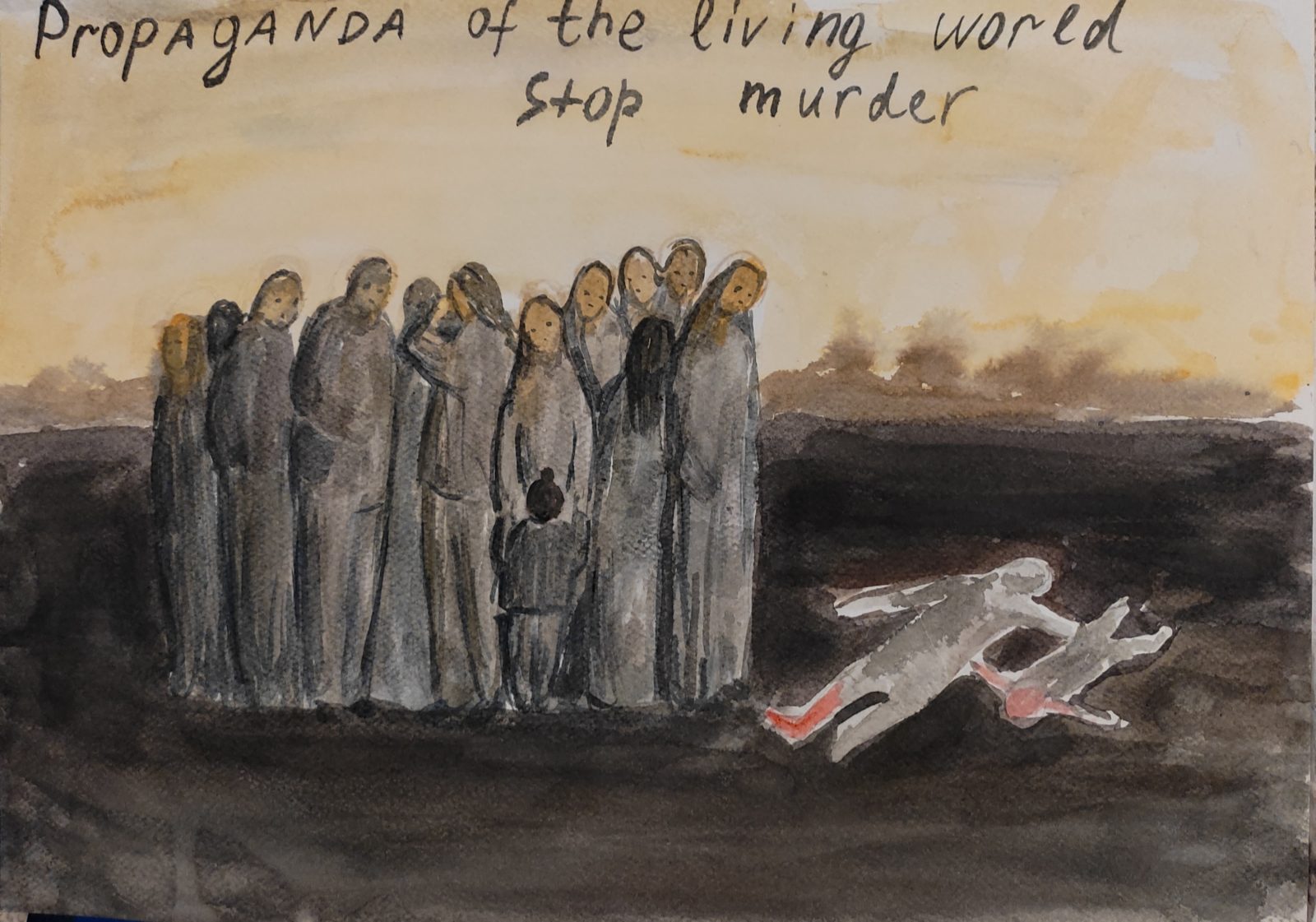
Kateryna Lysovenko, Propaganda of the living world. Stop murder. 2022. Image courtesy of the artist Kateryna Lysovenko.
The living world, human and non-human relations, care for the world but also the care of a mother for her child had been Kateryna’s topics well before the war. Arriving in Poland, lost and disoriented, her children deeply traumatized, she got a residency support from BWA Zielona Góra. There she goes back to large-scale painting: human figures get more shape and sometimes even faces, they are mostly female, carrying or holding, sometimes cradling children. She’s almost back to her usual imagery with a few striking exceptions, however: on most works, the colors are gone or faded, and once in a while, maybe on especially emotionally hard days, the strong corporeality of bodies shrinks again to small, shapeless figures, piled up in a mass graves or spread on the ground, raped, bleeding.
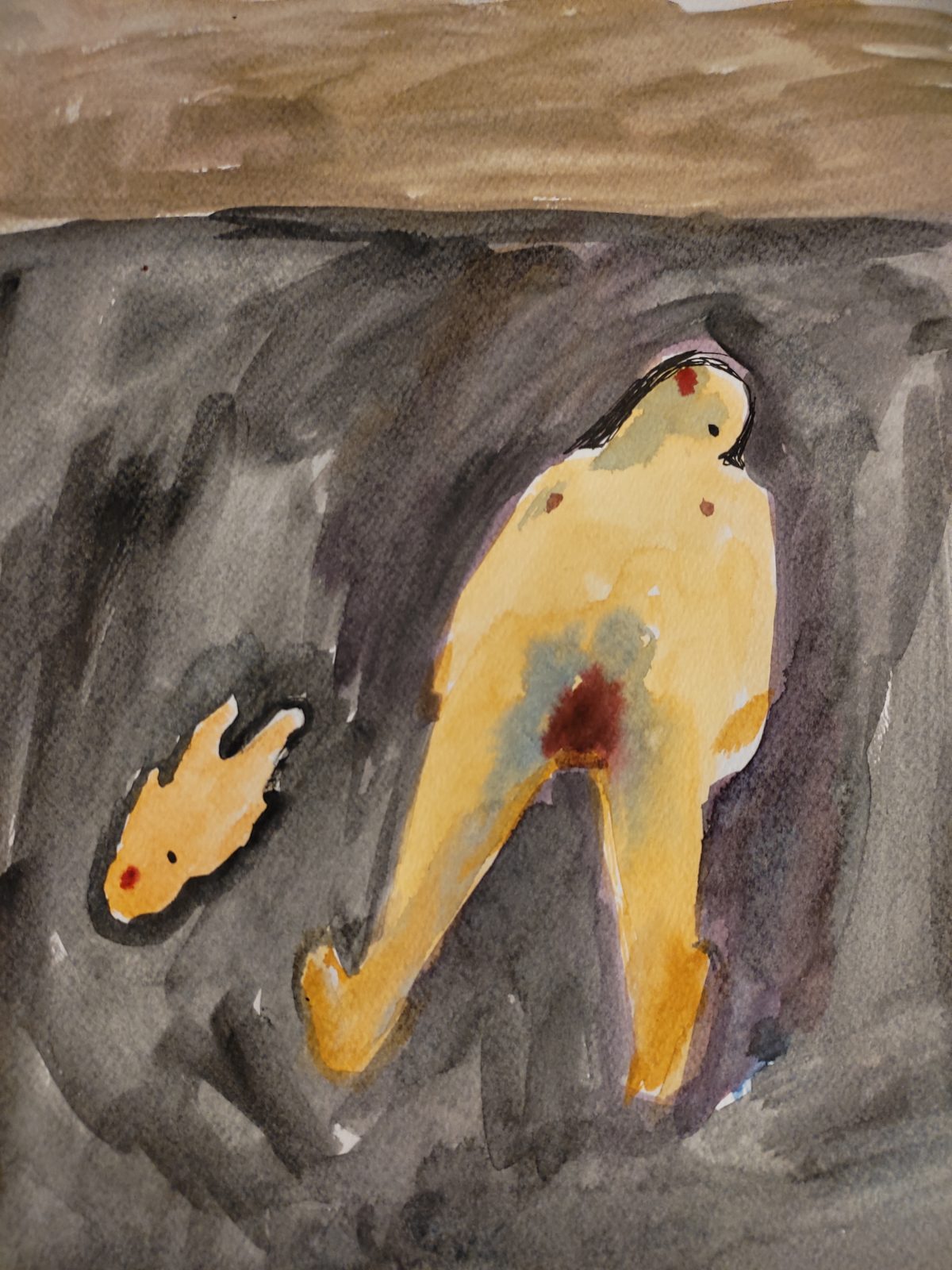
Kateryna Lyvosenko, They Can Repeat. 2022, published on Instagram. Image courtesy of the artist Kateryna Lysovenko.
Accompanying the images of her works on her Instagram, another diary of the war, the artist writes, ‘I carry gardens of sorrow, gardens of anger from irreparable loss, I remember everything that disappears, I want to breathe deeper to accommodate more, I am now a moving cemetery.’
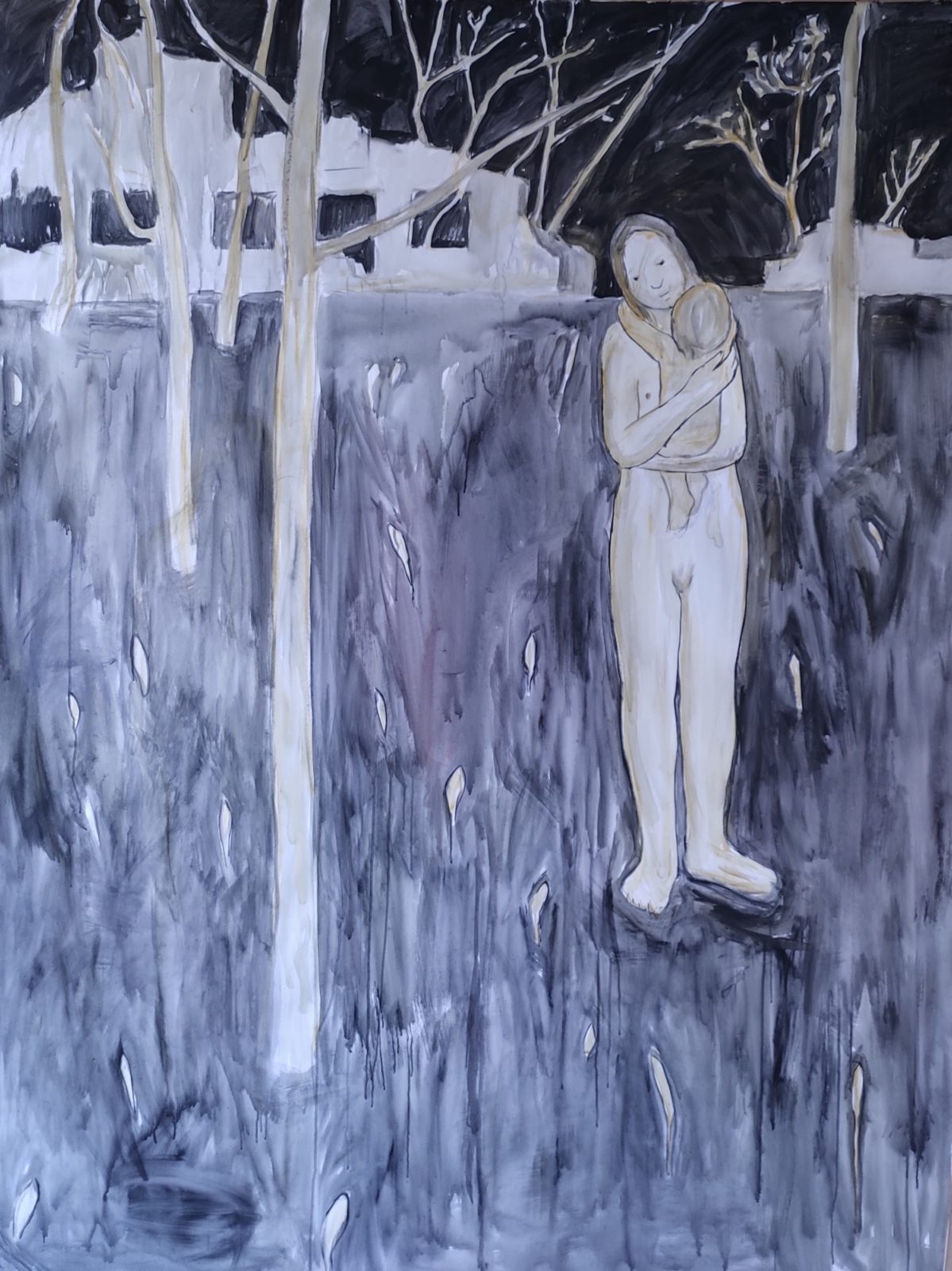
Kateryna Lysovenko, Gardens of Sorrow. 2022, published on Instagram. Image courtesy of the artist Kateryna Lysovenko.
Bodies, shapeless ones looking more like outlines or abstract figurines or more definitively feminine, are one of the main symbols in the imagery of this war. Shapeless ones usually come en masse – in bomb shelters or train stations. Female ones, naked and apparently vulnerable, protect, embrace, or stop the tanks, like in the works of the female artist who works under the alias Kinder Album; iothers grow into and with the nature, turning into birds, animals or vegetation, like in works by Sana Shakhmuradova.
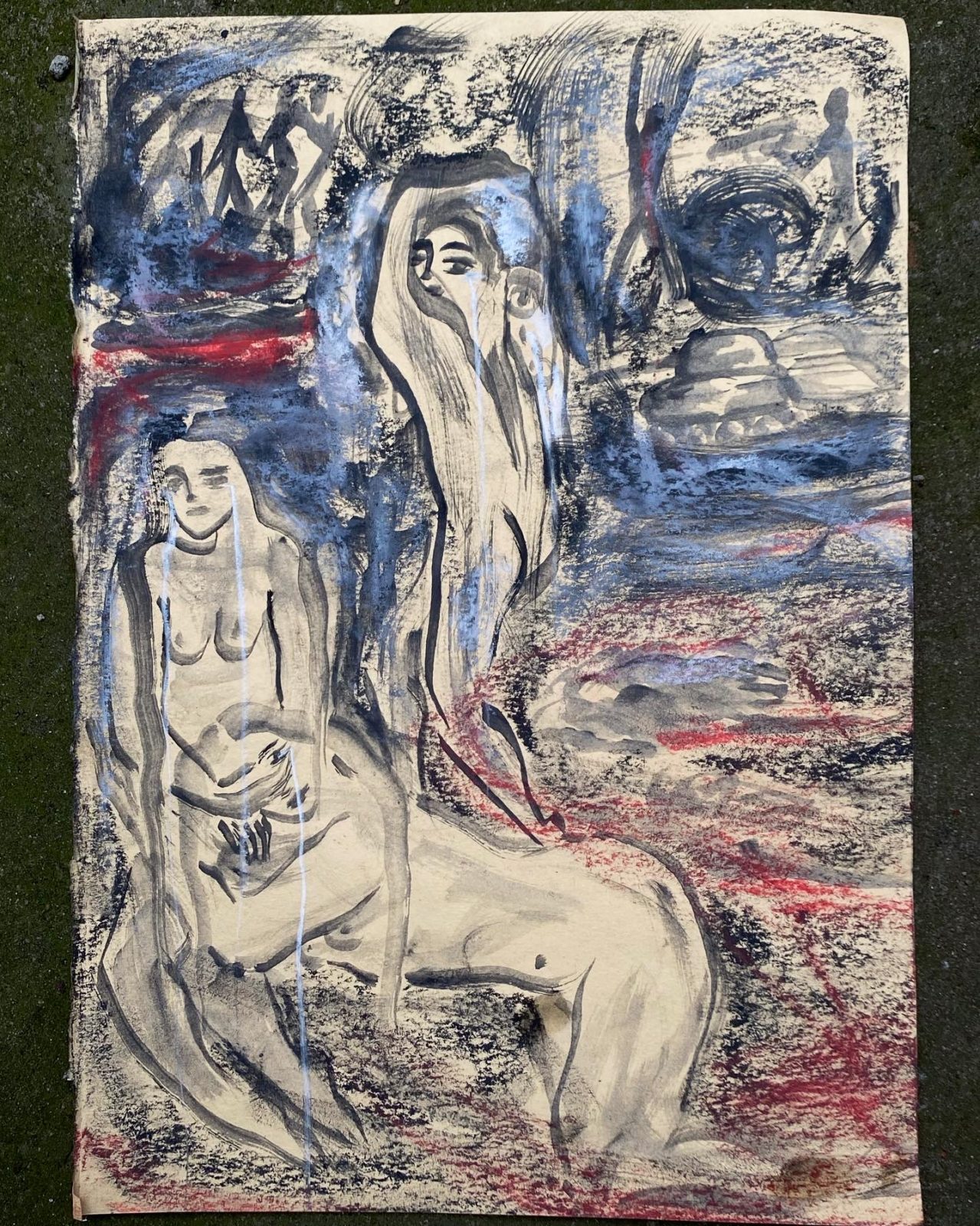
Sana Shakhmuradova: Dedicated to victims (women, children, civilians) raped, tortured, suffered and died because of Russian inhumane attack and violence. 2022, published on Instagram. Image courtesy of the artist Sana Shakamuradova.
The imagery and symbolism of these and many other artists’ diaries are very simple and schematic, lines are fast, colors are rough, emotions are raw. Even if already exhibited somewhere in exile, these works are still mostly meant as notes to oneself, semi-public diaries available on social media, a regular exercise in seeing and feeling without a chance to escape.
They remind of what is seen should never become unseen and what’s been understood can never be dismissed. The overwhelming reality of this war needs to find its way onto the physical surface of paper, canvas, or wall, to stop it from being forgotten.
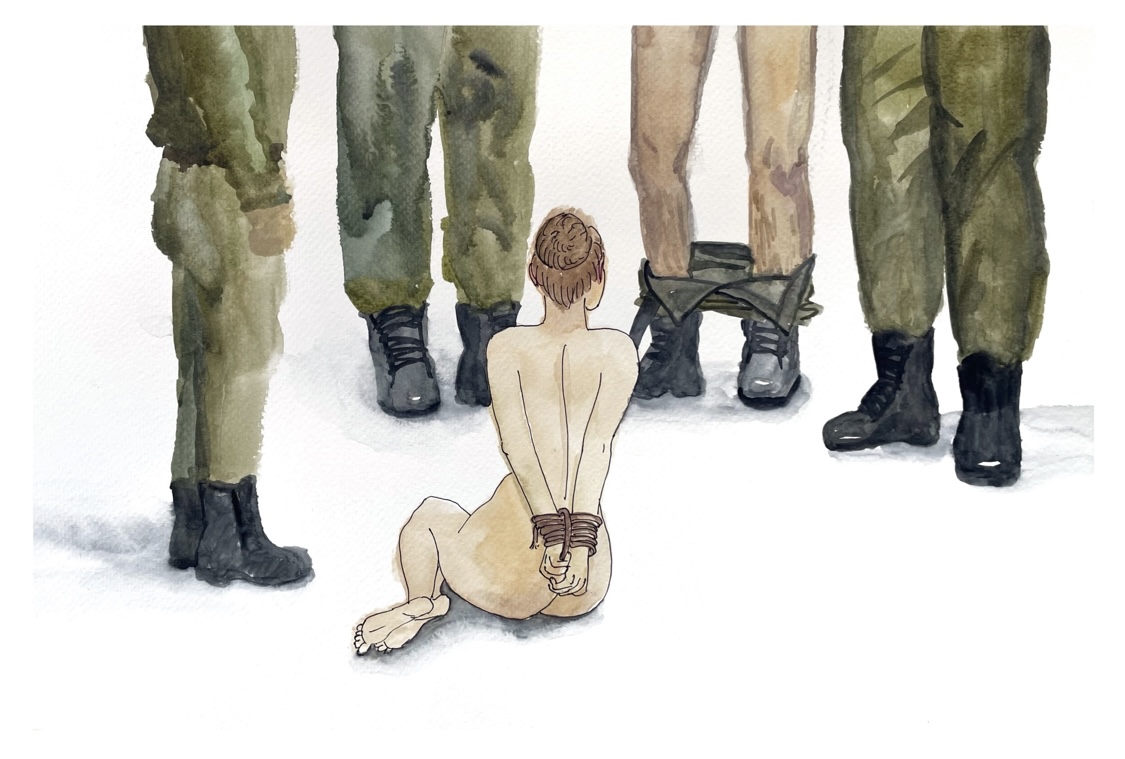
Kinder Album, Russian Soldiers Rape Women in Ukrainian Cities. 2022, published on Instagram. Image courtesy of the artist Kinder Album.
As for male artists and the male imagery of the war, the silence is even more literal. Many notable artists as well as writers, actors, film directors, researchers, and other intellectuals, voluntarily enlisted either into the army or into the territory defense units. The works they could have drawn, painted, written, filmed, is now covered in the throbbing silence of the war.
Testimonial
International discussions about the role and function of art in the war are tailored to notions like ‘healing’ and ‘peaceful mutual understanding.’Neither of these are expressed in the current works of Ukrainian.
It is testimony, it is the evidence of the tragedy that should have never happened, but indeed it has. It’s a powerful emancipatory work to create a visual language that can grasp these events, the loss, the emotions; to record this particular present in a new, uncomfortable yet distinct voice.
After the first major wave of the pandemic, Cameroonian philosopher Achille Mbembe wrote, ‘fundamental vulnerability is the very essence of humanity (2).’
Art conceived as a daily practice of seeing and enduring is an evidence to this fundamental vulnerability.
(1) Judith Butler Frames of War. When Is Life Grievable? (London: Verso, 2010)
(2) Mbembe, Achille. ‘The Weight of Life. On the Economy of Human Lives.’ Eurozine. https://www.eurozine.com/the-weight-of-life/. Publication date: 06.07.2020.





